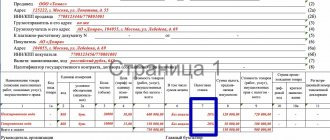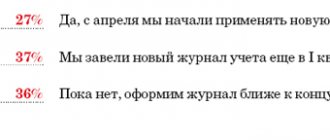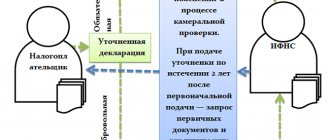“Invoices” or “invoices” – how to say and write correctly? This concept is used quite often, but the question of the correct declension by case and determining the gender of the word “invoice” still arises. And anyway: is this a word or a phrase? Our material will give you the answer to how to use “invoice” when writing and speaking according to all the rules of competent speech.
Also see:
- Invoice and delivery note as one single document
- Certification of invoice: signatures and seal
How is an invoice different from an invoice?
First let's separate these 2 terms, which sound similar but mean completely different things. We are talking about an invoice and an invoice. Let's take a closer look at how an invoice differs from an invoice.
The term “Account”
An invoice is a document according to which payment for goods/work/services is made to a counterparty.
An invoice cannot be considered a primary document. The primary is designed to reflect the accomplished facts of economic life. The account reflects only the desire of one business entity to receive funds for its goods or services from another business entity. When payment occurs, then we can talk about a fait accompli. activities. But for this they use other documents. For example, a bank statement or a cash receipt/expense order.
You can make a payment without having an invoice in hand. For example, in the case of systematically provided services, the price of which remains unchanged from month to month: payment may be made on the basis of an agreement. This condition must be written down in it.
Despite the optionality of using accounts in work, their use is convenient. Invoicing:
- we remind the counterparty that it is time to pay;
- We provide our bank details to the counterparty in a convenient format;
- We monitor the debts of counterparties with proper organization of document flow.
The term “Invoice”
An invoice is one of the most important documents in accounting. It is on the basis of the invoice that VAT is deducted - that is, they receive the right to reduce the tax payable. The invoice is covered in Art. 169 of the Tax Code of the Russian Federation.
It is relevant for organizations paying VAT. These are usually large companies. But small businesses, for various reasons, can apply the general taxation system with the payment of VAT.
Therefore, the term “invoice” is a frequently used one. This is a compound word, so it is not entirely obvious how to use it correctly. Below we will tell you what rules of the Russian language it obeys.
Now let’s summarize in a diagram what is the difference between an invoice and an invoice:
UPD or SSF?
By letter No. ММВ-20-3/96 dated 10/21/13, the tax service recommends the use of UTD in accounting, and the use of invoices is enshrined in the Tax Code of the Russian Federation as mandatory. When choosing a document that records VAT amounts, taxpayers often refuse UTD for precisely this reason.
There are more compelling reasons indicating that it is not advisable to replace an invoice with an UTD:
- Restrictions on UPD format. According to the legislation, the UPD in paper form can be used comprehensively in accounting and accounting or only as an accounting document. It can only be used electronically as an invoice (according to Pr. No. ММВ-7-15/155 dated 03/24/16).
- Advance payments. Letter No. ММВ-20-3/96 records cases in which UPD is used (shipment of goods, transfer of property rights, provision of services). Advance payments are not mentioned in the list. Only an invoice is issued for the advance payment (Article 168-3 of the Tax Code of the Russian Federation).
- Adjustments. Changes in value, quantity of inventory items, and property rights lead to the need to use an adjustment invoice. In accounting, an act or a similar document is usually drawn up and signed, reflecting the difference between the original and changed indicators, the agreement of the parties to change the terms of shipment (the so-called credit note and similar ones). When using an adjustment UPD, all this information (VAT adjustments, adjustments for differences in indicators) will have to be reflected in one document. Considering that in practice, business situations have many nuances, this can cause difficulties and slow down the preparation of documents. It is much easier to draw up two different documents, make adjustments to them and register them.
- Corrections. If it is necessary to correct the invoice data, a new copy is issued (Rules for filling out the SChF, clause 7, Permanent Law No. 1137), while the number and date of the document cannot be changed. It is easier to make corrections in accounting documents; for example, digital information is simply crossed out, the date of correction is marked, and the responsible person signs next to the entry. As in the previous case, it is easier to use the financial statements and primary accounting documents for the transaction separately.
In addition, the structure of the accounting service at some enterprises (agricultural, manufacturing) involves the use of several copies of primary accounting documents, for example, in warehouse accounting and summary reports of responsible persons of departments, the same invoice is used. The use of UPD in this case does not make sense.
Question: Is it possible to issue a correction invoice when returning a product if a UCD was issued when it was sold, and vice versa - to issue a UCD instead of an invoice and invoice? View answer
From this point of view, the universal transfer document is recommended for use in small and medium-sized businesses, with a limited number of business transactions and a small staff of accounting employees.
Important! The use of UPD, as well as the use of invoices, must be reflected in the accounting policies of the organization. It is advisable to approve the used form of UPD (adjustment UPD) by local regulations. When switching to UPD in the middle of the year, additions to the accounting policies should be introduced before the start of the tax period.
Choosing the correct declination
So, an invoice is not a combination of words, but one word - a compound one.
Compound words are words consisting of 2 or more words that are written with a hyphen.
Let us turn to the laws of literate speech for complex words consisting of several.
The words “invoice” and “invoice” are declined each separately, therefore, when declension by case of “invoice”, we decline each word:
Features of agent invoices
The Tax Code of the Russian Federation does not establish at what point the agent must re-issue an invoice to the principal.
But the agent’s procedure for drawing up invoices to the principal has the following features:
- in line 1 you need to indicate the date the invoice was issued by the seller, and the number - according to the registration of the agent;
- in line 5 enter the payment details for transferring money (from the principal to the agent and from the agent to the seller);
- in lines 6, 6a, 6b, the agent indicates the principal’s details;
- the remaining lines repeat the data given in the seller's invoice.
The date on the agent's reissued invoice must be the same as the date on the invoice received from the seller.
Principles for using words in the plural
How is the word invoice pronounced when we are talking about several documents? That is, if we are dealing with the plural.
The same apply here as for the singular: we decline each of the two words of the compound word.
Let's show what the word “invoice” looks like in the plural:
Let's write down examples of invoice declination if we have in mind not one document, but several:
Invoice: declination
Accountants often make mistakes when using the word invoice.
Thus, many people leave the first part of a compound word unchanged when declining. It is not right. Why we need an invoice, we wrote in the article.
Read the article on how to fill out an invoice.
When declension of a compound word remains unchanged, only that part of it that does not wander separately. An example of such a word: cocoa beans. The word “cocoa” is not declined in Russian, therefore, even when the compound word in which it is included remains unchanged even when declined. But in the compound word “invoice” the first part - “invoice” - is declined. That is, according to the rules of grammar, both components of the word “invoice” are declined.
So, for example, it is correct to write:
- I sent an invoice (accusative case).
- Invoice received (nominative case).
- There was an error in the invoice (prepositional case).
- I didn’t receive an invoice from you (genitive case).
- Questions may arise regarding this invoice (dative case).
- Rules for working with electronic invoices (fundamental case).
When using the word “invoice” in the plural, the rules for using this name remain the same. Examples of declension of a term in the plural:
- The invoices sent were formatted with errors (nominative case, plural).
- These invoices are missing (genitive, plural).
- You should look into the invoices of this individual entrepreneur (dative case, plural).
- Issued all invoices to you on time, expect by mail (accusative case, plural).
- What will happen to invoices next year (fundamental case, plural).
- About invoices, you need to read the regulations (prepositional case, plural).
The word “invoice” in the nominative case should answer the question “what?”, in the genitive - “what?”, in the dative - “what?”, in the accusative - “what?”, in the instrumental - “what?” and in the prepositional - “about what?”.
Prepositions are often used with the word “invoice” in the genitive case: before, without, from, at, from, for, with, about, around, except, after. In the dative case there are prepositions po and to; in the accusative - on, about, in, for, through. This compound word in the instrumental case is often used with the prepositions under, for, with, between, above. And in the prepositional - with the prepositions about, in, with and on.
Subscribe to our newsletter
Yandex.Zen VKontakte Telegram
Errors arise not only when declension of the word “invoice”, but also when filling out this document. How to correct errors made when filling out an invoice, read in “ConsultantPlus”. If you do not have access to the system yet, take advantage of the free trial access.
Correct gender
An important question is what type of “invoice”? Intuitively, the conclusion suggests itself that this is feminine, based on the last word - texture. But this is a mistaken opinion.
The gender of a compound word is determined by the gender of the defining, main word. In our case, this is the first word - count.
Counting is masculine. We get the conclusion: invoice also applies to masculine words.
How to correctly use the term “invoice” from the point of view of belonging to the genera, we show in the diagram:
To practice using the term “invoice” correctly, you can read articles and regulations in which this word appears frequently. For example, re-read this article and pay attention to the spelling of a difficult word. The invoice is also often found in the already mentioned article. 169 of the Tax Code of the Russian Federation.
Agent Responsibilities
An agent who purchases goods for a principal and acts on his own behalf under the contract is obliged to:
- send to the principal copies of invoices issued by the seller;
- issue invoices to the principal for the purchased goods and the advance payment transferred to the seller;
- provide an agent’s report with all primary documents accompanying the purchase attached (Article 1008 of the Civil Code of the Russian Federation);
- keep a log of invoices (clause 3.1 of Article 169 of the Tax Code of the Russian Federation).
Read in the berator “Practical Encyclopedia of an Accountant”
Intermediary agreement related to the purchase of goods








